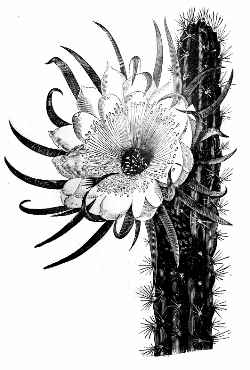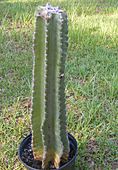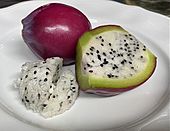Peruvian apple cactus facts for kids
Quick facts for kids Peruvian apple cactus |
|
|---|---|
 |
|
 |
|
| Drawing of flowering stem | |
| Scientific classification | |
| Synonyms | |
|
Cereus peruvianus |
The Peruvian apple cactus is a really tall and spiky plant. Its scientific name is Cereus repandus. You can find this amazing cactus growing in South America. People also call it the giant club cactus or hedge cactus. In some places, it's known as cadushi or kayush.
This cactus is often grown just because it looks cool. But it's also important for food in some areas. The Wayuu people, who live in Colombia and Venezuela, even use the strong wood from inside the cactus to build houses!
Description
This cactus often looks like a tree. Its stems are shaped like cylinders and can be gray-green or blue. They can grow up to 10 meters (about 33 feet) tall on their own. The stems are also about 10 to 20 centimeters (4 to 8 inches) wide.
Sometimes, with help from a support, a Peruvian apple cactus can grow even taller! One Cereus repandus in India grew to an amazing 33.5 meters (110 feet) tall. This might make it the tallest cactus ever recorded. But in nature, most cacti don't grow taller than 25 meters (82 feet).
The cactus stems have about nine to ten rounded ribs. These ribs are small, only up to 1 centimeter (less than half an inch) high. The small spots where the spines grow, called areoles, are far apart. The spines themselves are gray and look like needles. They can be very different from one cactus to another. Some have many spines, while others have none at all. The longest spines can be up to 5 centimeters (2 inches) long.
Flowers and Fruit
The Peruvian apple cactus has large, cream-colored flowers. These flowers open only at night and stay open for just one night. They are very important for bats, which help pollinate the cactus.
The cactus also grows tasty fruits. These fruits are called pitaya or Peruvian apple. In some parts of Bolivia, they are called olala. The fruits don't have any thorns. Their skin can be violet-red or yellow. Inside, the fruit has white flesh with small, crunchy seeds that you can eat. The flesh gets sweeter as the fruit fully opens.
Since this cactus grows in dry places and produces fruit during the dry season, its fruit is a very important food source for birds in its natural home.
Images for kids
See also
 In Spanish: Cereus repandus para niños
In Spanish: Cereus repandus para niños







